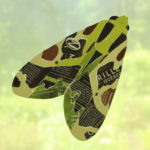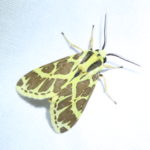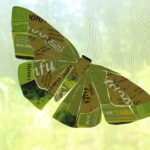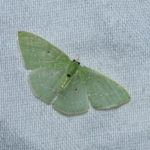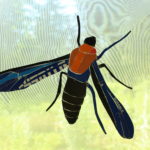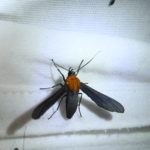Moths of Cloud Bridge by Maya Akazawa – An Online Art Exhibit
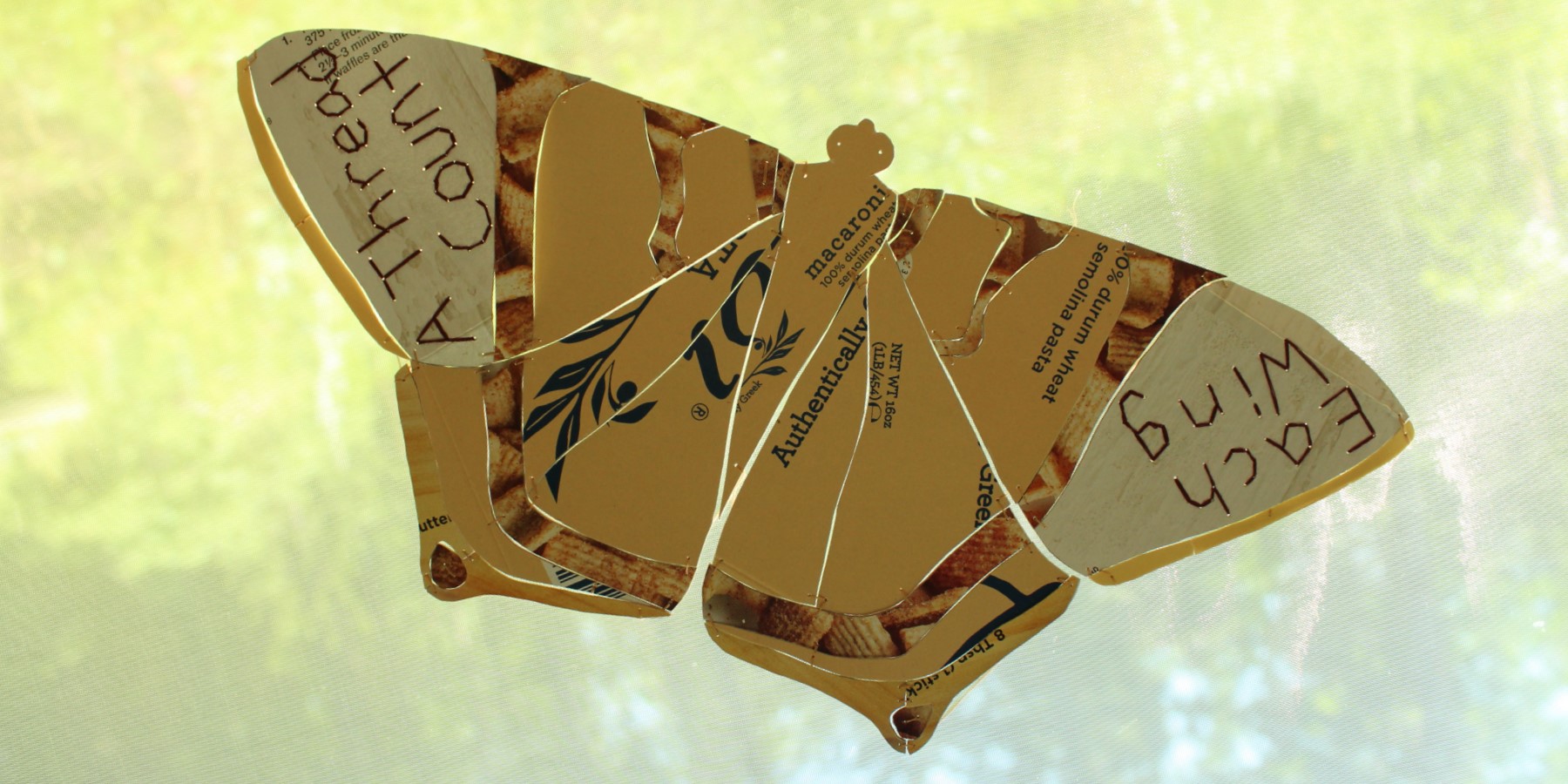
In celebration of National Moth Week (July 18-26), we're delighted to host this "e-opening" of Moths of Cloud Bridge, a multimedia collage and embroidery exhibit by Maya Akazawa, featuring moths encountered "at the sheet" at the Cloudbridge Nature Reserve in the rainforests of Costa Rica.
Part of the NBNC family since she was 6 years old, Maya combines her love of moths with years of studying Visual Arts. Maya's work incorporates unconventional materials, fiber arts, and the idea that "anything can be embroidered!" To see Maya's full exhibit, please click the button below.
Earlier this week, we also had the chance to sit down for an interview with Maya to discuss her artwork, her process, the joys of moths, and the connection between art and the natural world. Please enjoy our conversation below!
An Interview with Maya Akazawa
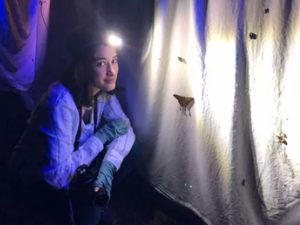 NBNC: When did you first get interested in moths?
NBNC: When did you first get interested in moths?
MA: I first got interested in moths and butterflies taking the Biodiversity University class at NBNC last summer. Everyone there was so much more experienced than I was! I was completely new to identification, and I didn’t even have the Peterson field guide, but everyone there was so welcoming, helpful, and enthusiastic about having someone in the course who was younger.
I wasn’t hooked until about day 4. I realized I wanted to get into moths when I saw another participant, Ann-Marie, holding a 10-pound camera in one hand and two moths on a leaf in the other. I was like, “wow, that’s so awesome. I want to be able to hold a 10-pound camera and do this.” She was so engaged, and she explained how she was doing it, the type of lighting needed, how to pose moths against cool backgrounds... and it was amazing watching her working with live moths to get amazing photos.
Over the winter, I discovered the Emmet Gowin book and thought “wow, there are so many more moths out there than just those in Vermont!” They’re all so colorful and amazing to look at, and they definitely inspired my art a lot. Those moths were vastly different yet similar in shape and patterns to Vermont moths. There were also new details that I hadn’t seen before, which was really influential in my textile art.
NBNC: How would you compare the moths here to the moths in Costa Rica?
MA: For me, the difference in Costa Rica was how much larger the moths were. The environment is larger, and there seemed to be more diversity of larger species there. Here, we’re more limited in the large things like sphinxes and royal silk moths that we see. There were some really big ones in Costa Rica.
I noticed these amazing metallic moths in Costa Rica, but I didn’t realize those were in Vermont until last night, when I found this beautiful Bronzed Alder Moth. It’s white with gold streaks, and it’s this tiny little thing— it reminded me so much of moths in Costa Rica. In both places, you’ll find these little sparkly gems on your moth sheet. There’s definitely also similarity in body shapes between there and here. I’ve been looking through my Peterson moth guide for our area, and I keep finding the same moths here that I saw in Costa Rica!
NBNC: Who are some of your big artistic inspirations?
MA: Meredith Woolnough’s work got me started with my textile art. She’s an Australian artist, and she does biomimicry with machine embroidery. Although I’m not showing machine embroidery for this gallery, I actually started out doing machine embroidery by copying Emmet Gowin’s moth pictures. It really inspired me to go to Costa Rica and do my own “mothing” there.
Woolnough uses thread and textiles to create these entirely new pieces, and that was a huge influence for my own desire to create pieces that imitated nature. I’ve also taken classes on new ways of doing embroidering, which gave me the freedom to explore with different mediums. We embroidered squashed cans and litter from the side of the road, and it taught me that, “wow, I can embroider anything. I don’t have to stick to fabric!”
NBNC: How did you develop such a multimedia-based style?
MA: My initial interest was in fashion at Interlochen Arts Academy, where we were using a lot of recycled materials like plastic bags and harder items. That was my path into multimedia—using unconventional materials. Moving away from fashion, I still wanted to keep that element of unconventional materials, and that led me towards collage, and using things like recycled food boxes in my art.
Multimedia is really popular right now. A lot of my friends do multimedia, and I’m taking a class right now with Amy Wynne where we’re doing collage combining different mediums like sewing paper and magazines. Multimedia just adds more to what you’re doing. It adds depth of concept, and it adds texture when you actually touch it, because there’s more than one material in the piece.
NBNC: What’s the deeper connection between your art and your interest in the natural world?
MA: There’s an ephemeral quality to each moth. I like looking at a moth and trying to preserve its shape and color in my art, instead of pinning it or making a replica. It’s ephemeral, it’s delicate, and that shows up a lot in my process because embroidery is usually known as being delicate too. There’s a lot of variety in colors and patterns in nature, which I find really fun to imitate.
When I’m working with materials, especially recycled materials, I try to keep an open mind as to whether the words and patterns on that material are going to work with the patterns I see in the natural world. I’ve noticed that there’s a similarity or a merging between the materials and the natural world. A lot of my work is about simplification: taking the patterns already existing, and simplifying them so I can convey them. It’s hard to replicate natural patterns because they’re so complex.
NBNC: When people see your gallery, what do you hope people will walk away with?
MA: I really am hoping to convey my experience of having FUN with moths. A lot of people don’t like insects because they think they’re creepy, or they itch, or they’re going to bite you. I used to think insects were so gross! I once thought I was bitten by a moth... that actually isn’t even possible. But I was terrified of moths, and now I’m not. I want the audience to take away that moths are beautiful, and a hidden gem of the natural world that can be seen if you look a little harder or turn on a porch light. They’re not creepy-crawlies.
NBNC: How does someone get started “mothing?”
MA: You might be mothing already without even knowing it if you leave your porch light on! If you want to look at them, they might still be on your porch or on your wall the next morning. If you want to photograph them, or if you want to see a lot more, just hang up a white sheet on a clothesline and point some flashlights or a UV light (if you want to get serious) at them. Then just wait. You can do it anywhere—there will always be something that shows up, whether you’re in the city, or in suburbia, or in the woods. There are plants everywhere, so there are moths everywhere.
NBNC: What other projects do you have going on right now?
MA: I’m doing an embroidery text messaging project right now where I take photographs and embroider people’s text messages onto them. I started them this winter for an AP Art project after taking that class on embroidery with unconventional materials. I’m doing more collage right now—this summer I’m working on landscape and still life collage involving embroidery and color-aid paper.
NBNC: What is the significance of the words embroidered on the wings of your moths?
MA: Last year, I was assigned to write a poem about climate change, and I decided to write about monarchs and butterfly migration. So when I started this moth project, I thought “I’m going to put the poem on the moths!” I simplified the poem, and I embroidered as many words as I could fit onto the wings. Here’s the full poem:
Stained Glass Windows
Moving From 1 place to Another
Migrating to
Oceans, lakes, fields, mountains
To places not yet seen
A carpet of Stained glass
Each Wing a Thread Count
Dwindling
Where will they go?
When the Ground is covered by Repetition?
NBNC: What are your plans for the future?
MA: I’m an upcoming senior in high school, so I’ll be applying for colleges soon. I’d like to go into entomology. I’ve always enjoyed natural science and art, and I think entomology and art go together (it does in my experience!). I don’t know exactly where my art will take me, but I’m going to branch out into new styles, and maybe try to work more on painting. I’ll definitely keep up with embroidery though, as it is a very personal part of my craft and a part of the aesthetic of my art.

